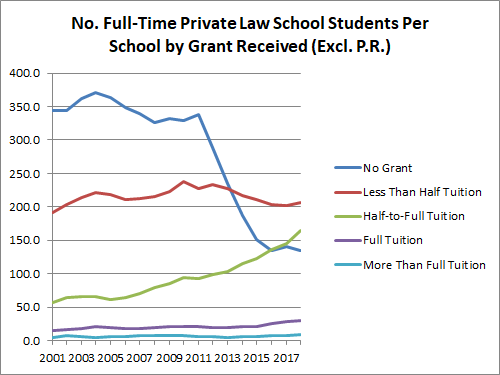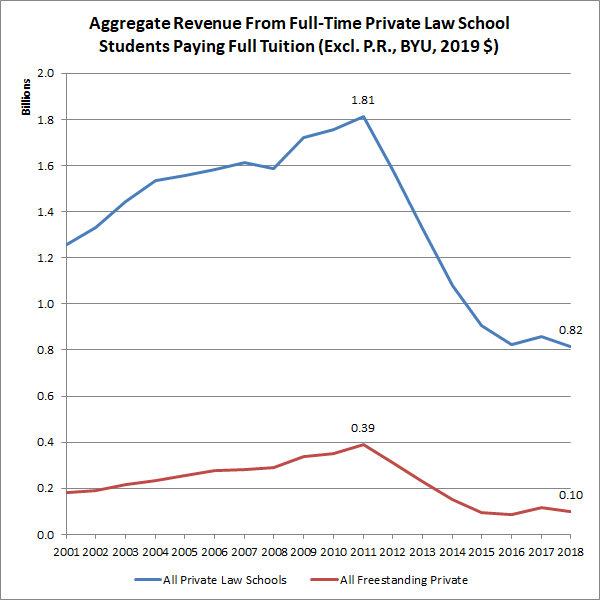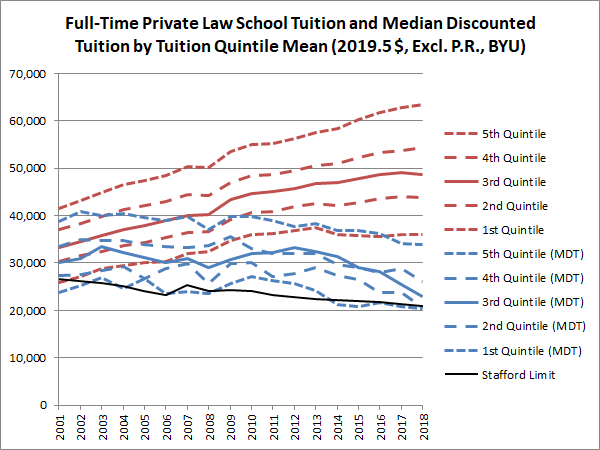Discussions of law-school costs are incomplete if they do not account for discounts some students receive, usually merit scholarships paid for by their full-tuition-paying classmates. To analyze the phenomenon of discounting, I focus on the ABA’s 509 information reports’ scholarship data. This information lags the academic year by one year, so as of the 2019-20 academic year, we now have data on 2018-19.
At the average law school not in Puerto Rico in 2018, the proportion of full-time students paying full tuition fell by 2.2 percentage points from 25.6 percent to 23.4 percent. At the median law school now not even one in five students pays full tuition.
The proportion of students paying full tuition has declined considerably over the years. At the turn of the century, more than half of students paid full cost; now about a quarter do.

At private law schools, which are easier to analyze because they don’t price discriminate in favor of resident students, the average number of students receiving grants ranging between half and full tuition now clearly exceeds the number paying full tuition. Many more receive a grant worth less-than-half tuition, though their numbers have flattened.

One advantage of knowing how many full-time students pay full tuition is that we can estimate the total revenue they generate for private law schools, except Brigham Young, which charges LDS students less.

Since 2011, the peak year, inflation-adjusted revenue from full-tuition-paying full-time students has fallen 55 percent. Since 2001, the first year for which data are available, the drop is 35 percent. In 2018, the median private law school’s full-tuition revenue was $4.4 million, down from $13 million in 2011 but up 9 percent since 2016. In 2001, the median was $9.6 million. This is quite a decline.
So how substantially are private law schools discounting? The best way to answer that question is by using the sticker price at private law schools as the independent variable, and treating as the dependent variable their tuition after subtracting their median grant (median-discounted tuition “MDT”). First I divide private law schools into full tuition quintiles and give their mean averages. Then I take mean of the MDTs within each quintile.

We find that while full tuition inexorably climbs upward and disperses, the MDTs are trending downward and converging, indicating significant discounting. Notably, the MDT at the most expensive law schools is about as much as full tuition at the cheapest private law schools.
And now for the most important segment of this report: ridicule of law schools for clearly misreporting scholarship data to the ABA:
- This year’s winner was also last year’s, so it gets a special commendation. Mitchell | Hamline gave out 445 grants to full-time students when it only enrolled 442. Keep on with the basic errors in arithmetic, M|H.
- Number 2 is Idaho’s second law school, Concordia, whose future was recently put in doubt. It may seem unfair to kick a law school when it’s down, but fair is fair, and other troubled law schools did better. Concordia gave 129 grants to only 116 full-time students for a -13 full timers paying full tuition.
- South Dakota itemized full-time scholarship data but nevertheless reported 0 receiving any full-time grants. Oops.
- Florida Coastal subtly misreported its less-than-half-, half-to-full-, full-, and more-than-full-tuition grants at 130 altogether, yet its total full-time students receiving grants numbered 156. Who are the 26 mystery recipients, Florida Coastal? Who?
- Baylor’s itemized grant recipient numbers also don’t add up. It specified grants to 378 students out of 381.
- Finally, Nebraska engaged in a similar misreporting, but only chalked up one mystery recipient.
Six is pretty bad, but at least only the first two were negative recipients.
Information on this topic from previous years:
- “2017: Full-Time Law Students Paying Full Tuition *Rises* By 0.4 Percentage Points” (January 14, 2019)
- “2016: Full-Time Students Paying Full Tuition Fell by 2.4 Percentage Points” (January 8, 2018)
- “2015: Full-Time Law Students Paying Full Tuition Fell ~5 Percentage Points (Again)” (January 11, 2017)
- “Full-Time Students Paying Full Tuition Fell ~5 Percentage Points in 2014” (January 4, 2016)